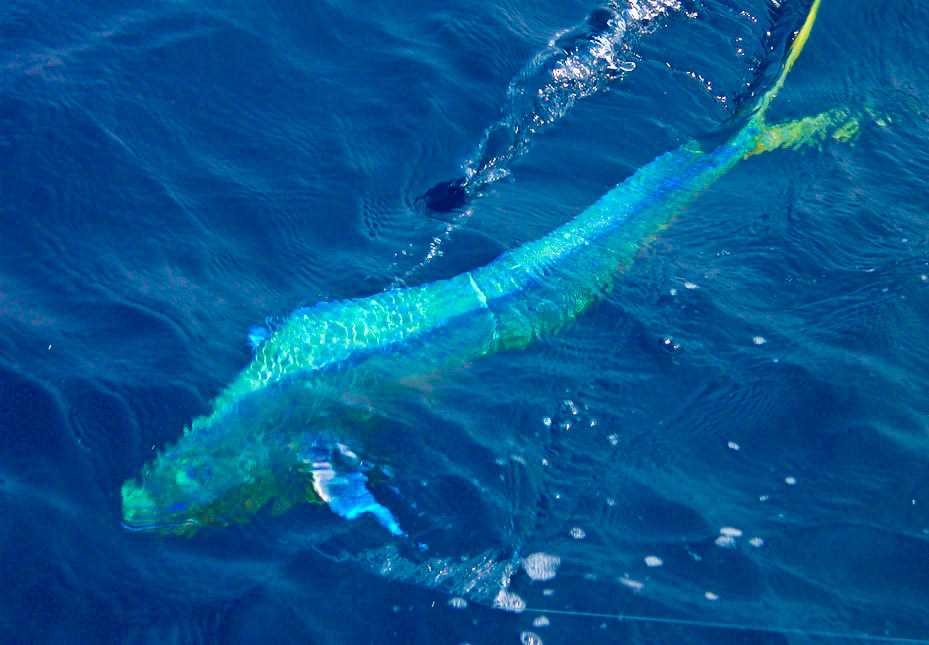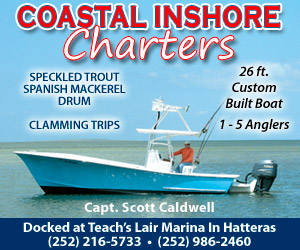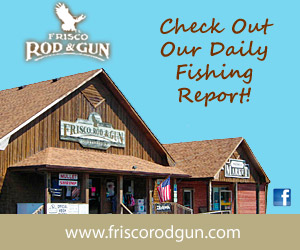
NOAA Fisheries announces the final rule for Amendment 10 to the Fishery Management Plan for the Dolphin and Wahoo Fishery of the Atlantic (Dolphin Wahoo Amendment 10). Dolphin Wahoo Amendment 10 and the final rule will revise the acceptable biological catch, annual catch limits, sector allocations, accountability measures, and management measures for dolphin and wahoo.
The management measures address:
- commercial trip limits,
- authorized fishing gear,
- the operator permit (card) requirement for dolphin and wahoo, and
- the recreational vessel limit for dolphin.
When Rule Will Take Effect:
Regulations become effective May 2, 2022.
Summary of Changes:
- The changes will apply to the dolphin and wahoo fishery in federal waters from Maine, south to the Florida Keys in the Atlantic.
Dolphin
| Catch levels (pounds [lbs] whole weight [ww]) | |
| Total Annual Catch Limit
(= Acceptable Biological Catch) |
24,570,764 lbs ww |
| Sector allocations (percent [%] of total annual catch limit) | |
| Commercial | 7% |
| Recreational | 93% |
| Sector annual catch limits (pounds [lbs] whole weight [ww]) | |
| Commercial | 1,719,953 lbs ww |
| Recreational | 22,850,811 lbs ww |
| Recreational Vessel Limits*(excluding Headboats) | |
| 54 per vessel | |
**The 10 dolphin per person per day recreational bag limit will remain unchanged for all recreational vessels (private, charter vessels, and headboats).
Wahoo
| Catch levels (pounds [lbs] whole weight [ww]) | |
| Total Annual Catch Limit
(= Acceptable Biological Catch) |
2,885,303 lbs ww |
| Sector allocations (percent [%] of total annual catch limit) | |
| Commercial | 2.45% |
| Recreational | 97.55% |
| Sector annual catch limits (pounds [lbs] whole weight [ww]) | |
| Commercial | 70,690 lbs ww |
| Recreational | 2,814,613 lbs ww |
Recreational Accountability Measures:
Post-season recreational accountability measures will be triggered in the following fishing year if:
Dolphin
- The total annual catch limit is exceeded.
Wahoo
- The recreational annual catch limits are constant and the 3-year geometric mean of landings exceeds the recreational annual catch limit.
Recreational post-season accountability measures for both dolphin and wahoo after the trigger:
- Reduction in the length of the following recreational fishing season by the amount necessary to prevent the recreational annual catch limit from being exceeded in the following year.
Commercial trip limits:
- Currently, a person in the exclusive economic zone may only have certain authorized gear onboard when they are in possession of dolphin and wahoo.
- Trap, pot, and buoy gear are not authorized gear.
- Some fishermen want to harvest dolphin while in the possession of lobster pots.
- This final rule will allow for a new category of commercial trip limits for dolphin and wahoo based on a proposed authorized gear exemption for trap, pot, and buoy gear, and the trip limit would be 500 pounds (lbs) gutted weight of dolphin and 500 lbs of wahoo.
- There currently is an incidental commercial trip limit of 200 lbs of dolphin and wahoo, combined weight, for vessels that do not have a dolphin wahoo commercial permit but do have another federal commercial permit and catch the species north of the 39 degrees north latitude. This trip limit will not be able to be combined with the commercial trip limit with the authorized gear allowance.
Operator cards:
- The current requirements for operator cards and permitted operators for both the dolphin and wahoo commercial and charter vessel/headboat permitted vessels will be removed.
Goals and Objectives:
- The revised goals and objectives seek to manage the dolphin and wahoo fishery using a precautionary approach that maintains access, minimizes competition, preserves the social and economic importance of the fishery, as well as promotes research and incorporation of ecosystem considerations where practicable
Frequently Asked Questions
Why are the catch limits for dolphin and wahoo being increased?
- In April 2020, the South Atlantic Fishery Management Council’s Scientific and Statistical Committee recommended new acceptable biological catch levels for dolphin and wahoo using the third highest annual commercial and recreational landings value during 1994-2007.
- The revised total annual catch levels are set equal to the revised acceptable biological catch levels.
How will the increase in catch limits affect dolphin and wahoo populations?
- The increase in catch limits is not expected to adversely affect dolphin and wahoo populations.
- The dolphin population is not considered overfished or undergoing overfishing and the population status of wahoo is unknown.
- Both dolphin and wahoo are highly migratory, exhibit fast growth, and are highly productive.
Why are the commercial and recreational allocations for dolphin and wahoo being changed?
- The commercial and recreational allocations are based on commercial and recreational historical landings.
- Estimates of recreational landings have changed to incorporate Marine Recreational Information Program’s Fishing Effort Survey method, which has replaced the Marine Recreational Information Program’s Coastal Household Telephone Survey.
- When determining allocations, the Council recognized the needs of the recreational sector for dolphin and wahoo, which would exhibit higher landings than previously estimated, with the new accounting of recreational landings using Marine Recreational Information Program’s Fishing Effort Survey method.
- At the same time, the Council did not want to reduce the commercial annual catch limits on a pound basis for dolphin and wahoo and noted that the proposed allocations and sector annual catch limits would strike a balance between the needs of both sectors.
Why are the recreational accountability measures for dolphin and wahoo being changed?
- The current recreational accountability measures are post-season and based on population status.
- The post-season accountability measures are not viable because they cannot be triggered as there is no peer-reviewed population assessment for dolphin and wahoo, and therefore, there is no likely method to determine their population status.
- The revised recreational accountability measures trigger would help ensure sustainable harvest by preventing the total annual catch limit from being exceeded on a consistent basis.
Why are gear authorization and commercial trip limits changing?
- Currently, a person in the exclusive economic zone may only have certain authorized gear onboard when they are in possession of dolphin and wahoo.
- Trap, pot, and buoy gear are not authorized gear.
- Some fishermen want to harvest dolphin while in the possession of lobster pots.
- This final rule will allow for a new category of commercial trip limits for dolphin and wahoo based on a proposed authorized gear exemption for trap, pot, and buoy gear, and the trip limit will be 500 pounds gutted weight, of dolphin and 500 pounds of wahoo.
- There currently is an incidental commercial trip limit of 200 pounds of dolphin and wahoo, combined weight, for vessels that do not have a dolphin wahoo commercial permit but do have another federal commercial permit and catch the fish north of the 39 degrees north latitude. This trip limit will not be able to be combined with the revised commercial trip limit including the newly authorized gear allowance.
- The current dolphin commercial trip limit of 4,000 pounds once 75% of the commercial annual catch limit is reached will not change.
Why is the requirement for operator permit (card) being removed?
- The operator permit requirement was implemented in 2004, through the original fishery management plan for dolphin and wahoo, as a way to assist in law enforcement efforts within the fishery by holding the vessel operator accountable for any violation of regulations and to aid in data collection.
- Since then, the operator permits are not actually used by law enforcement for gathering data, distributing information, or enforcement to a large extent. Other methods of fishery enforcement, such as vessel permits and landings have been used by law enforcement within the fishery.
- The Council determined that the limited use that operator permits in the dolphin and wahoo fishery did not outweigh the cost to fishermen to obtain the permit, and removing this requirement would yield positive social, economic, and administrative benefits.
Why is the recreational vessel limit for dolphin decreasing?
- Interest in recreational harvest of dolphin has increased over the years. Also, public testimony, especially from fishermen in Florida, recommended a decrease in the recreational retention limits to further control recreational harvest.
- The Council determined a coast-wide reduction in the vessel limit was appropriate to maintain consistency of regulations across the region in the retention limits for dolphin and noted that such a change in retention limits would lead to more substantial harvest reductions than a Florida-specific or regional approach.
Why is the recreational bag or vessel limit for wahoo not decreasing?
- The Council considered reducing the recreational bag limit for wahoo from the current 2-fish per person to 1-fish per person, but removed this action from the amendment because data analysis showed only a 2.9% reduction in recreational landings.
- Public input was received against moving to a 1-fish per person bag limit due to the low estimated reduction in landings.
Where can I find more information on Dolphin Wahoo Amendment 10?
Dolphin Wahoo Amendment 10 may be found online at the NOAA Fisheries Southeast Regional Office Website at: https://www.fisheries.noaa.gov/action/amendment-10-changes-catch-levels-sector-allocations-accountability-measures-and-management/.





